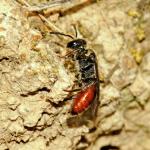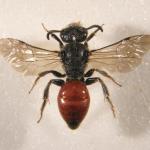Sphecodes hispanicus WESMAEL 1836; Sphecodes rufipes SMITH 1853; Sphecodes gibbus var. Tunetanus GRIBODO 1894; Sphecodes atrohirtus PÉREZ 1903
This species has also been known as S. ruficrus (Erichson) and S. rufiventris (Panzer), but both were misidentifications.
Essentially, a southern species, found from Devon to Kent and north to West Suffolk. Also known from South Wales. Abroad, found throughout much of central and southern Europe, and western Asia.
Not mentioned in Shirt (1987), but listed by Falk (1991) as Notable A, (now known as Nationally Scarce Na).
Found in old, herb-rich meadowland, and soft-rock coastal cliffs and landslips.
Univoltine. Early May to mid-July. The males emerge in the spring rather than late summer or autumn; unusual for halictine bees including most Sphecodes. This flight period is in synchronization with that of the host: Andrena, rather than Lasioglossum or Halictus.
A cleptoparasite of Andrena labialis, with which it is usually recorded, and possibly, A. flavipes. The parasitic behaviour has not been well documented.
The species has been reported visiting angelica (Angelica sylvestris), wild carrot (Daucus carota) and spurges (Euphorbia spp.) for nectar only.
No information available.
2006



